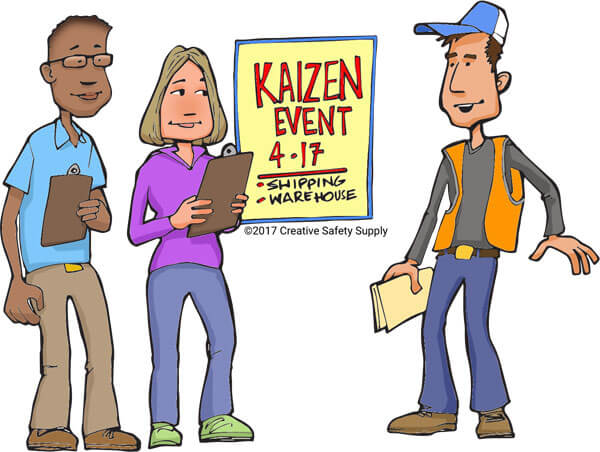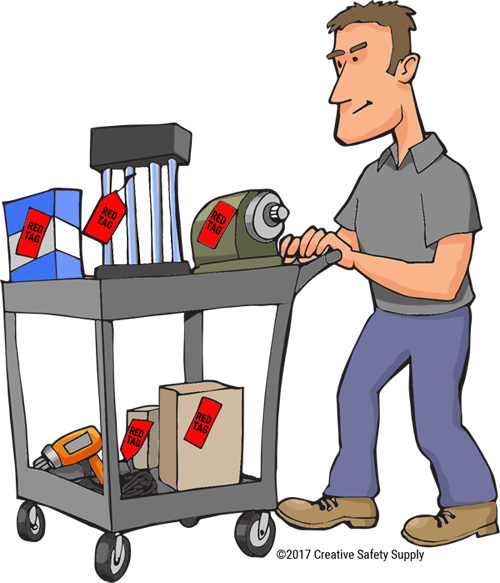
Kaizen events are single, coordinated, events designed to make some type of improvement over a set period of time. There are many different ways that a Kaizen event can take place depending on the type of company, what system it is being used as a part of, and more. One key thing to remember about a Kaizen event is that it should not be looked at as an ongoing effort. Learning how to use Kaizen events to eliminate waste and improve profits is well worth the effort.
Kaizen is a Japanese word that is translated as 'change for the better' or sometimes, 'continuous improvement.' The Kaizen method is used for process improvement and improving productivity by taking small steps that will lead to major results.
Kaizen Events in Lean Manufacturing
 Kaizen events are most often used as part of an overall lean manufacturing strategy. Lean manufacturing is an important process that helps a facility eliminate waste and operate more efficiently. When done properly, a company can cut costs and improve safety, thus helping every aspect of the company. There are many different benefits of Kaizen events, which is why they are so popular in many facilities.
Kaizen events are most often used as part of an overall lean manufacturing strategy. Lean manufacturing is an important process that helps a facility eliminate waste and operate more efficiently. When done properly, a company can cut costs and improve safety, thus helping every aspect of the company. There are many different benefits of Kaizen events, which is why they are so popular in many facilities.
In order to have a lean manufacturing facility, it is necessary to identify areas of waste and eliminate them. Sometimes waste can simply be eliminated with a simple process change. When it will require something more complex, a Kaizen event can be an excellent solution.
A Kaizen event will work to not just learn more about the waste that needs to be eliminated, but also come up with an effective way to address it throughout the facility. Ideally, a single event will address a specific example of waste in the facility. Once the event has concluded, the waste should either be eliminated or reduced to planned levels.
Planning an Event
The first step in any Kaizen event is going to be planning it out. This will start with identifying what type of problem, or waste, needs to be addressed. There are many ways that a problem can be addressed through a Kaizen event. Some common examples of what can be done through an event include:
- Process Changes - One of the most common ways to reduce or eliminate waste in a facility is by making changes to an existing process.
- Training - Providing training to employees can help to ensure they are performing activities properly, which will ensure everything is operating as efficiently as possible.
- Physical Changes - Making adjustments to the physical layout of a facility can help to reduce waste. Positioning machines in such a way as to allow better flow during the manufacturing process.
- Standardization - Making sure that activities are done in the same way by all employees will allow everyone to benefit from proven practices. Standard work is an important element of Kaizen.
- Other - There are many other things that can be done to help improve efficiency and eliminate waste in the workplace. Kaizen events can help opportunities for improvement.
Identifying the Scope of the Kaizen Event
 When planning a Kaizen event, it is necessary to look closely at the scope of it. In some cases, a company can be too granular, so the event is so small in scope that it really doesn't make any noticeable changes. These small improvements can often be done 'on the fly' or through meetings to make quick changes.
When planning a Kaizen event, it is necessary to look closely at the scope of it. In some cases, a company can be too granular, so the event is so small in scope that it really doesn't make any noticeable changes. These small improvements can often be done 'on the fly' or through meetings to make quick changes.
The more common issue with the scope of events is when they become too large or encompassing. An event shouldn't try to fix all of the problems that exist within a facility, but instead focus on one significant, but specific issue. Choose an area or process that needs to be improved, and identify how it will increase the value to a customer. Once done, this will serve as the scope of the event.
Choosing an Event Team
With the Kaizen methodology in general, everyone in a facility will be participating. With a Kaizen event only a small team will be working on the change. In most cases, a team will consist of between six and ten members. When choosing a team, the goal should be to have members from all interested parties, and get as well-rounded a group as possible. These are some points that should be considered when planning:
- Those Directly Impacted - At least half of the team should be made up of individuals who will be directly impacted by the changes that are made during the event.
- Limited Leadership - Only one or perhaps two members of the management team should be involved directly. They can provide oversight, but having too many managers will end up limiting the solutions that are developed by the other members of the team.
- Multiple Departments - In addition to those in the direct department impacted, related departments should be involved too. If making changes to one machine, the team that receives the parts from it should also have representation.
- Subject Matter Experts - Bring in subject matter experts to help answer questions and provide guidance.
- Consider Outsiders - If the change will have an impact on customers, vendors, or other non-employees, consider bringing them into the team. They will be there to get an outside perspective on potential changes.
- Objective Party - Finally, bring in someone from the company who will not be at all impacted by the project. This objective third party can often identify potential issues that would have otherwise been overlooked, or provide an objective opinion should there be conflict.
Holding a Kaizen Blitz
A Kaizen event will typically last anywhere from a few hours all the way up to a week, depending on its complexity. These events are normally broken up into specific and measurable phases, which include:
- Start the Event - When starting an event, the facilitator will explain the scope of the event to the team, and do basic introductions.
- Establishing a Baseline - Taking down information about how things currently operate, and gathering as much data as possible is critical. It will offer a baseline of data that can be used for comparisons after the event is completed.
- Designing a Proposed Solution - Coming up with a proposed solution for the problem being worked on may take the bulk of the event. Look for non-value-adding aspects of the current system, and come up with ways to eliminate them.
- Test - One the team agrees on a proposed solution, it should be tested. This can be done on real machines, simulations, or other options depending on the issue. If any issues are identified, repeat the previous step and then retest until the desired results are achieved.
- Implement Change - Finally the change will be implemented into the production process. This is where physical changes are made, and any changes to the processes will be implemented.
Post-Event Process
After the change is implemented, the official event has concluded. The team should be gathering data after the change so that in the coming days or weeks, it can be compared to the baseline data that was gathered. This will be how the success of a Kaizen event will be measured. If the data does not show success, the team may need to get back together to attempt to find another solution.
If the Kaizen event was particularly challenging or long-lasting, many companies will hold 'post-event celebrations' to congratulate the team. This can also be a time when any impacted parties that weren't part of the Kaizen team will be shown the new processes or changes. This can serve as a training event, as well as a celebration regarding the conclusion of the event.

